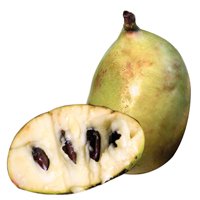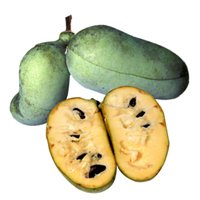 Full List of Fruits
Full List of Fruits  American Pawpaw
American PawpawAmerican Pawpaw
![]() Introduction of American Pawpaw fruit
Introduction of American Pawpaw fruit
Scientific name - Carica papaya
Pawpaw trees are the widest edible fruit trees that belong to North America. This tree produces the enchanting Pawpaw which is a mix of green and black. This fruit is generally confused with the papaya and custard apple.
Having a forest origin, this fruit is a queer mix of mango, citrus and banana taste. It is easy to cultivate. This fruit has bean-sized seeds and is cultivated wildly in 26 American states.
When you consume this fruit, you have to take the skin, slurp the pulp and then spit out the seeds. But again, they can also be used in breads, and sometimes as a substitute for bananas and mangos.
These distinct fruits are enjoyed by the American for centuries. But the question is: are they still relevant? Well, there is somewhat an awareness of this fruit nowadays.
These fruits consist of a short shelf life However, if you don't want to give up on this tasty fruit you can hunt in the woods thoroughly and pick the ripe ones. The flesh found inside the pawpaw is totally too soft.
In the current scenario, it is difficult to see this fruit in commercial markets. However, it is learnt that the domestication process is in full swing.
You get a pungent aroma out of this fruit. It is learnt that the American Indian cultivated this fruit.
![]() Description of American Pawpaw
Description of American Pawpaw
The American Pawpaw is a species of small deciduous tree native to the eastern United States and Canada. This species is often referred to as the common pawpaw due to its wide range of distribution. It is a member of the Annonaceae family, which is also known as the custpaw is a unique and tasty fruit native to North America. It is the only member of the Asimina genus, and the only temperate climate member of the family Annonaceae, which includes tropical fruits such as the soursop and cherimoya.
The American Pawpaw is a deciduous tree that typically grows between 10-30 feet tall and wide, with a spreading crown. The bark is smooth and gray and the branches of the tree are slender. The leaves are large, heart-shaped, and dark green in color. In the spring, the tree produces flowers that are small and yellow-green in color. The flowers are pollinated by flies and other insects, and eventually give way to the fruit of the tree. The fruit of the American Pawpaw is a unique and delicious treat. The pawpaw is a large berry-like fruit that is yellow-green in color when ripe. It has a custard-like flesh that is sweet and creamy. The flavor has often been described as a cross between a banana and a mango, and is often compared to a tropical fruit. The fruit also contains several small black seeds that are edible.
![]() Nutritional Value of American Pawpaw
Nutritional Value of American Pawpaw
| Principle | Nutrient Value | Percentage of RDA |
|---|---|---|
| Energy | 43 Kcal | 2% |
| Carbohydrates | 10.82 g | 8% |
| Protein | 0.47 g | 1% |
| Total Fat | 0.26 g | 1% |
| Cholesterol | 0 mg | 0% |
| Dietary Fiber | 1.70 g | 4% |
| Vitamins | ||
| Folates | 37 µg | 9% |
| Niacin | 0.338 mg | 2% |
| Pantothenic acid | 0.218 mg | 4% |
| Pyridoxine | 0.038 mg | 3% |
| Riboflavin | 0.027 mg | 2% |
| Thiamin | 0.023 mg | 2% |
| Vitamin A | 950 IU | 32% |
| Vitamin C | 60.9 mg | 102% |
| Vitamin E | 0.30 mg | 2% |
| Vitamin K | 2.6 µg | 2% |
| Electrolytes | ||
| Sodium | 8 mg | 0.5% |
| Potassium | 182 mg | 4% |
| Minerals | ||
| Calcium | 20 mg | 2% |
| Iron | 0.25 mg | 3% |
| Magnesium | 21 mg | 5% |
| Phosphorus | 10 mg | 1% |
| Zinc | 0.08 mg | 0.5% |
| Phyto-nutrients | ||
| Carotene-ß | 276 µg | -- |
| Crypto-xanthin-ß | 761 µg | -- |
| Lutein-zeaxanthin | 75 µg | -- |
![]() Health Benefits of American Pawpaw fruit
Health Benefits of American Pawpaw fruit
The powerful Anti-Cancer Plant.
It Protects Against Skin Damage.
Antioxidants in Papaya.
Improves digestion.
![]() Fertilization of American Pawpaw fruit
Fertilization of American Pawpaw fruit
The American Pawpaw is the only member of the genus Asimina, and is in the same family as the Papaya. The Pawpaw is an important food source for many wildlife species, including deer, bear, and turkey. The leaves are oval-shaped, and the flowers are yellowish green, with faint purple lines on the petals. The fruit is yellow-green with a brown or blackish skin. It is highly fragrant and sweet-tasting, and can be eaten raw or cooked. Like most fruit trees, the Pawpaw needs to be pollinated in order to produce fruit. Unfortunately, the tree is not self-pollinating, so it needs help from bees, insects, or wind-borne pollen in order to produce fruit.
In recent years, researchers have developed a method of hand-pollination for the Pawpaw. This involves transferring pollen from the male (staminate) flower to the female (pistillate) flower using a paintbrush. This method has been shown to increase yields of Pawpaw fruit, although it is labor-intensive and requires local knowledge of the species. Researchers have also developed a method of artificial fertilization for the Pawpaw tree. This involves collecting the pollen from the male flowers, mixing it with a special solution, and then spraying it onto the female flowers. This method has been shown to produce higher yields of fruit than hand-pollination, but it is still not as effective as having bees and other insects do the pollination.
American Pawpaw (Asimina triloba) can be used in recipes such as ice cream, pies, preserves, jams, and sauces. It can also be used to make juices, smoothies, and even alcoholic beverages such as wine and beer. The leaves of the American Pawpaw tree can be used as a tea, which is said to have a mild laxative effect. American Pawpaw can also be used as a medicinal plant. The leaves have been used to treat various ailments such as fever, colds, and digestive problems. The root bark is said to have anti-inflammatory properties and can be used for treating wounds and bruises. It is also said to have antifungal, antibacterial, and antiviral properties.
American Pawpaw can also be used in landscaping. It is a popular ornamental tree because of its unique foliage and colorful fruits. The tree is easy to grow and maintain, and it is drought tolerant, making it a great choice for gardeners in dry climates. It can also be used as a windbreak or shade tree. American Pawpaw is a great addition to any garden or landscape. It is a unique and nutritious fruit that can be used in a variety of ways. Its leaves can be brewed into tea, its fruit can be used in recipes, and its root bark can be used medicinally. It is an excellent choice for gardeners in dry climates, and it can be used as a windbreak or shade tree.



















